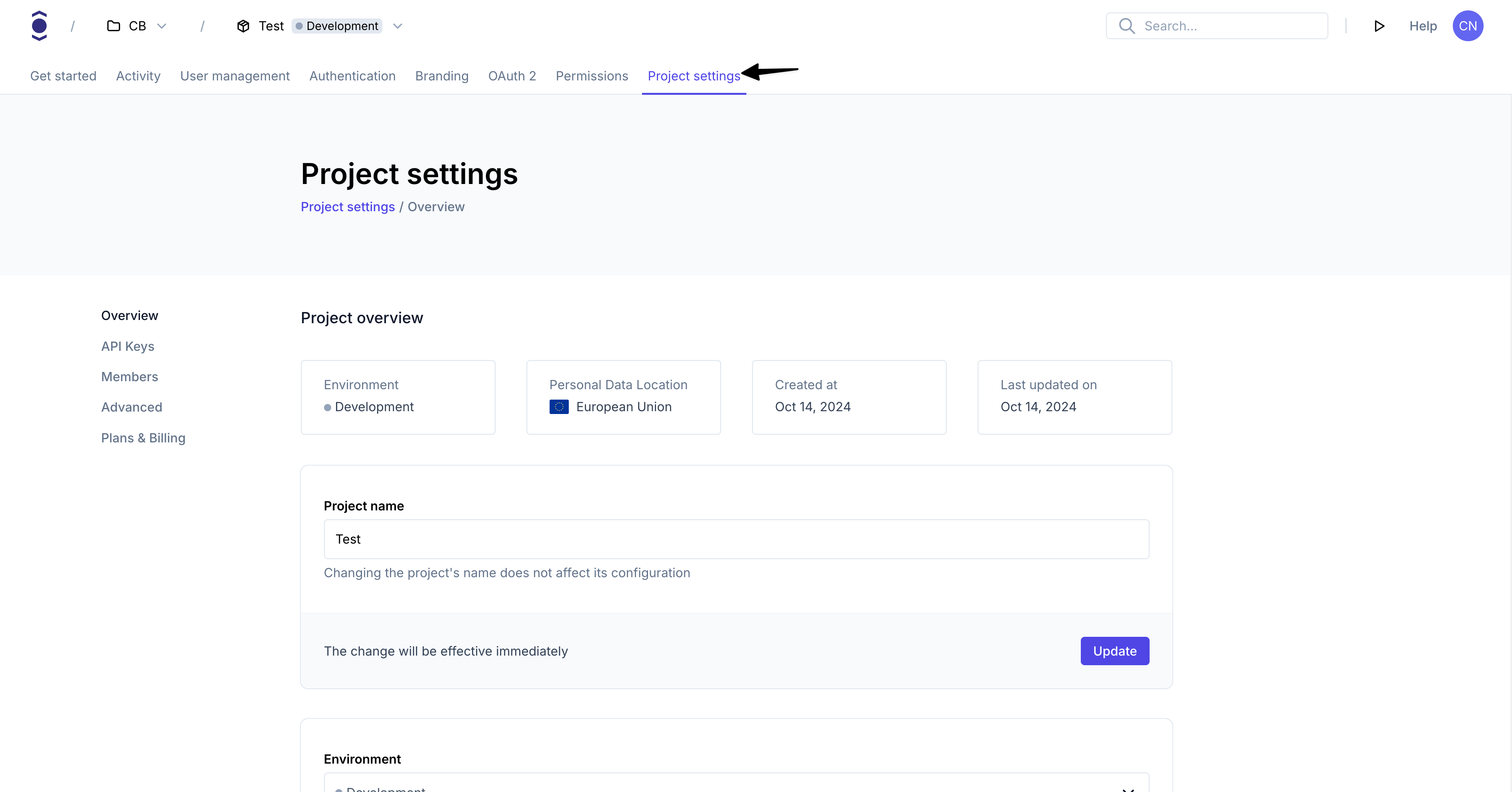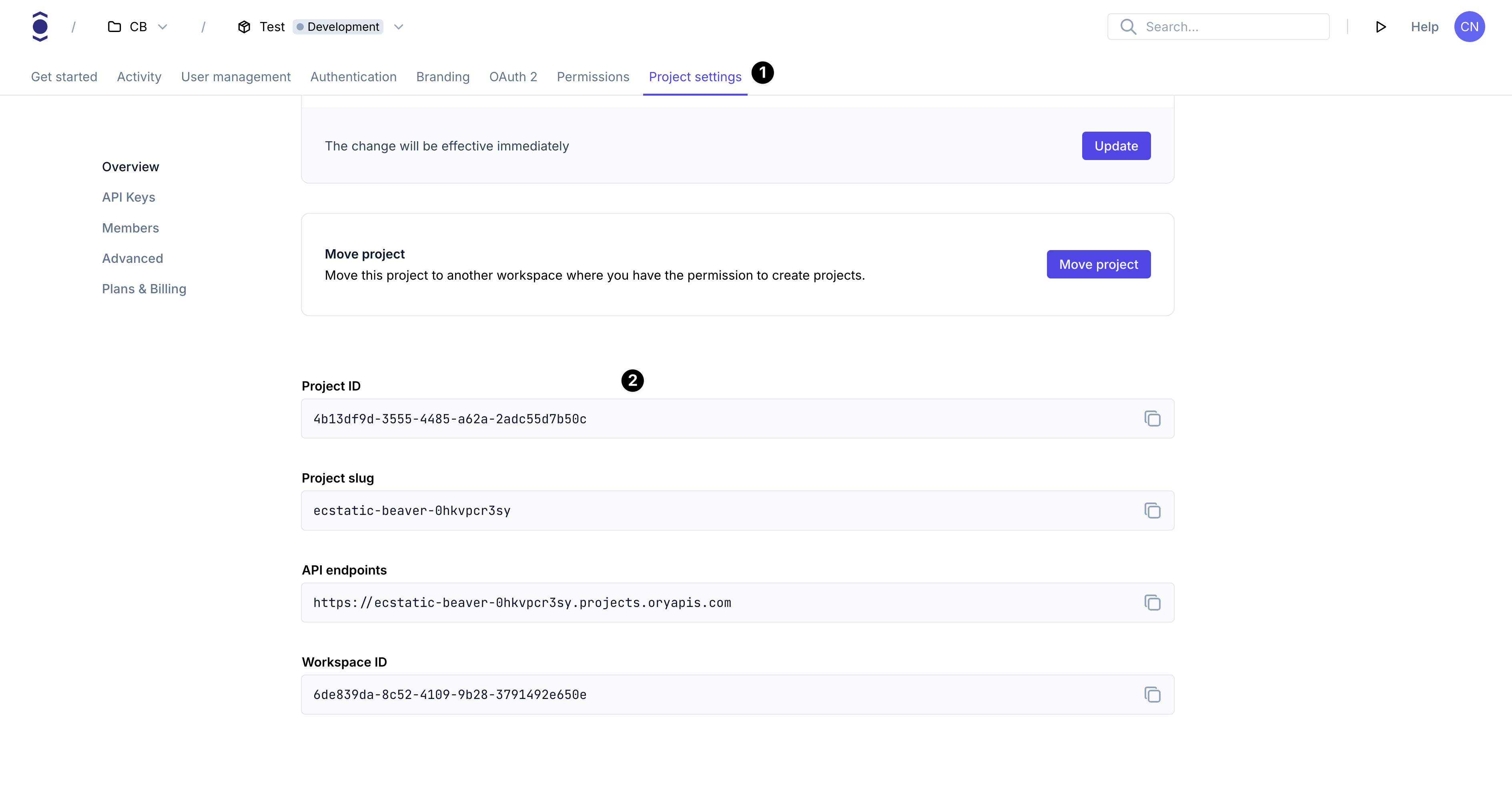Integrate authentication into ASP.NET
This guide shows how to create a simple ASP.NET application and secure it with authentication powered by Ory. You can use this guide with both Ory Network and self-hosted Ory software.
This guide is perfect for you if:
- You have .NET installed.
- You want to build an app using ASP.NET.
- You want to give access to your application to signed-in users only.
You can find the code of the sample application here.
Create ASP.NET app
Create an empty web template as a starting point for this example. Run these commands:
mkdir your-project
cd your-project
dotnet new web
Install Ory SDK
Run this command to install the Ory SDK:
dotnet add package Ory.Client
Create a new Ory project
- Create an Ory account at https://console.ory.sh
- Create a new project at https://console.ory.sh/projects/create
- Go to your project settings

- Note down your project credentials (ID, slug, endpoint)

Install Ory CLI
Follow this guide to install the Ory CLI on your machine.
Why do I need the Ory CLI
The Ory security model uses HTTP cookies to manage sessions, tokens, and cookies. Because of browser security measures like
CORS, Ory APIs must be exposed on the same domain as your application.
In the case of this example the application runs on your local machine. The cookie domain is localhost.
Use either localhost or 127.0.0.1 consistently. Although technically they refer to the same machine, browsers treat them as
different cookie domains.
Ory CLI provides a convenient way to configure and manage projects. Additionally, the CLI provides Ory Tunnel - a tool that ensures cookies match the domain your application is currently on.
To make Ory APIs and your application available on the same domain, Ory Tunnel mirrors Ory endpoints and rewrites cookies to match
the correct domain. As a result, the domain of the cookies is set correctly to the domain you run the app on instead of
<your-project-slug>.projects.oryapis.com.
By using the Tunnel, you can easily connect the application you're developing locally to Ory Network and consume the APIs without additional configuration or self-hosting any Ory services.
To learn more about the Ory Tunnel, read the dedicated section of the Ory CLI documentation.
Configure the SDK
Add the Ory Client to the template app. Make the following changes to the Program.cs file:
using Ory.Client.Api;
using Ory.Client.Client;
var builder = WebApplication.CreateBuilder(args);
// configure http port explicitly to override generated settings from launchSettings.json
builder.WebHost.ConfigureKestrel(opt => {
var port = builder.Configuration.GetValue<int>("APP_PORT", 3000);
opt.ListenAnyIP(port);
});
var app = builder.Build();
// create a new Ory Client with the BasePath set to the Ory Tunnel enpoint
var oryBasePath = builder.Configuration.GetValue<string>("ORY_BASEPATH") ?? "http://localhost:4000";
var ory = new FrontendApi(new Configuration
{
BasePath = oryBasePath
});
app.MapGet("/", () => "Hello World!");
app.Run();
Validate and login
Next, create middleware that checks if the user has a valid session. The session is considered valid when the user is authenticated.
The middleware passes the request cookies to the Ory Client to check if the session is valid.
If the session is valid, the user is presented with the protected page. When the session is not valid, which means that the user is not authenticated or the session expired, the request is redirected for login using the Ory Account Experience.
using Ory.Client.Api;
using Ory.Client.Client;
var builder = WebApplication.CreateBuilder(args);
// configure http port explicitly to override generated settings from launchSettings.json
builder.WebHost.ConfigureKestrel(opt => {
var port = builder.Configuration.GetValue<int>("APP_PORT", 3000);
opt.ListenAnyIP(port);
});
var app = builder.Build();
// create a new Ory Client with the BasePath set to the Ory Tunnel enpoint
var oryBasePath = builder.Configuration.GetValue<string>("ORY_BASEPATH") ?? "http://localhost:4000";
var ory = new FrontendApi(new Configuration
{
BasePath = oryBasePath
});
// add session middleware
app.Use(async (ctx, next) =>
{
async Task Login()
{
// this will redirect the user to the managed Ory Login UI
var flow = await ory.CreateBrowserLoginFlowAsync() ?? throw new InvalidOperationException("Could not create browser login flow");
ctx.Response.Redirect(flow.RequestUrl);
}
try
{
// check if we have a session
var session = await ory.ToSessionAsync(cookie: ctx.Request.Headers.Cookie, cancellationToken: ctx.RequestAborted);
if (session?.Active is not true)
{
await Login();
return;
}
// add session to HttpContext
ctx.Items["req.session"] = session;
}
catch (ApiException)
{
await Login();
return;
}
await next(ctx);
});
app.MapGet("/", () => "Hello World!");
app.Run();
The protected page
-
Create the
IndexRazorPage page that shows session data to users with a valid session.dotnet new page --name Index --no-pagemodel --output Pages -
Add this code to the
Pages/Index.cshtmlfile to present the data to the user:Pages/Index.cshtml@page
@{
// try to retrieve session from HttpContext
var session = HttpContext.Items.TryGetValue("req.session", out var item) && item is Ory.Client.Model.ClientSession s ? s.ToJson() : "<NO SESSION>";
}
<html lang="en">
<head>
<title>Ory Network secured ASP.NET Core web app</title>
</head>
<body>
<h1>Dashboard</h1>
<hr />
<h2>Your Session Data:</h2>
<pre><code>@session</code></pre>
</body>
</html>
Configure application
To configure the app to serve RazorPages, make the following changes in Program.cs. Make sure to replace the
app.MapGet("/", () => "Hello World!"); line with app.MapRazorPages();.
using Ory.Client.Api;
using Ory.Client.Client;
var builder = WebApplication.CreateBuilder(args);
// configure http port explicitly to override generated settings from launchSettings.json
builder.WebHost.ConfigureKestrel(opt => {
var port = builder.Configuration.GetValue<int>("APP_PORT", 3000);
opt.ListenAnyIP(port);
});
// add support for RazorPages
builder.Services.AddRazorPages();
var app = builder.Build();
// create a new Ory Client with the BasePath set to the Ory Tunnel enpoint
var oryBasePath = builder.Configuration.GetValue<string>("ORY_BASEPATH") ?? "http://localhost:4000";
var ory = new FrontendApi(new Configuration
{
BasePath = oryBasePath
});
// add session middleware
app.Use(async (ctx, next) =>
{
async Task Login()
{
// this will redirect the user to the managed Ory Login UI
var flow = await ory.CreateBrowserLoginFlowAsync() ?? throw new InvalidOperationException("Could not create browser login flow");
ctx.Response.Redirect(flow.RequestUrl);
}
try
{
// check if we have a session
var session = await ory.ToSessionAsync(cookie: ctx.Request.Headers.Cookie, cancellationToken: ctx.RequestAborted);
if (session?.Active is not true)
{
await Login();
return;
}
// add session to HttpContext
ctx.Items["req.session"] = session;
}
catch (ApiException)
{
await Login();
return;
}
await next(ctx);
});
// configure pipeline to use RazorPages
app.MapRazorPages();
app.MapGet("/", () => "Hello World!");
app.Run();
Test your application
With all of the pieces in place, it's time to test your application. Follow these steps:
-
Start the application:
dotnet run -
Run Ory Tunnel to mirror the Ory API endpoints on your application's domain (
localhost):ory tunnel --project playground --dev http://localhost:3000 -
Open localhost:3000 to access the application. As the initial call is made by an unauthenticated user, the middleware doesn't detect a valid session and redirects to the login page of the defined Ory project.
-
From there, you can create a new account or sign in using an existing identity. When you sign in, the session becomes valid and the application shows the
Indexpage with the session data.
To see a more advanced example of integrating Ory with ASP.NET Core check out the examples repository.
Go to production
You can use many different approaches to go to production with your application. You can deploy it on Kubernetes, AWS, a VM, a
RaspberryPi - the choice is yours! To connect the application to your Ory project, the app and Ory APIs must be available under
the same common domain, for example https://ory.example.com and https://www.example.com.
You can easily connect Ory to your subdomain. To do that, add a Custom Domain to your Ory Network project.
With the custom domain set up, you don't need to use Ory Tunnel to interact with Ory APIs. Instead, use the configured custom domain in your SDK calls.
// register a new Ory client with the URL set to the custom domain
var ory = new FrontendApi(new Configuration
{
BasePath = "https://ory.example.org"
});